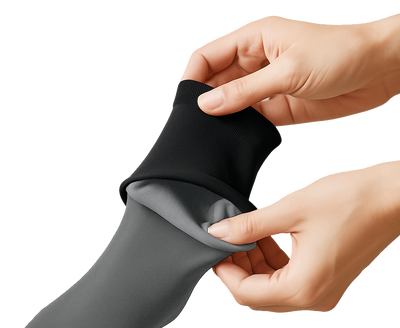What are medical-grade compression socks and stockings?

In modern days, compression socks and stockings are widely known amongst sportsmen and people who travel regularly. So when one hears the term ’compression socks’, he/she does not necessarily refer to their medical purpose.
The story about the compression socks started exactly out of the need to help treatment of the chronic venous disease of the lower extremities. Medical–grade compression stockings are specially designed for compression therapy. Compression improves blood circulation of the lower extremities, reduces pain, eases the feeling of hard legs, reduces the chances of circulatory issues, and helps people feel better in everyday life.

Types of the medical-grade stockings
There are three primary types of compression stockings and these are:
- Graduated compression stockings
- Anti-embolism stockings
- Nonmedical support hosiery
The first two fall under the category of medical–grade compression stockings and the third one refers to compression socks worn to during everyday activities.
Graduated compression stockings
As the name says, graduated compression stockings implement compression gradually. The level of compression is strongest at the ankle and gradually decreases towards the top of the legs. To choose adequate compression socks, one has to consult with a professional. Main factors for choosing the best medical-grade compression socks for you are the length of the socks and the level of compression.
Stockings that go up to the knee help limit peripheral edema. Peripheral edema is swelling of the lower legs or hands. Edema occurs when the homeostatic balance of fluid in our cells is disturbed. As a result, fluid is getting accumulated in our tissues making our legs feel heavy or stiff. Not every peripheral edema is the same.
There are various causes for edema related to temporary conditions. Conditions like injury, sitting or standing too long, or conditions that cause increased water retention like hormonal changes during the period or pregnancy, excessive salt intake, consuming some drugs, obesity, or wearing tight clothes may promote edema in your legs. This type of edema is a lighter version and it is not so hard to beat as they are the direct consequence of the named conditions.

Some more systemic causes of the edema include heart failure, the development of blood clot – a condition known as deep vein thrombosis, pericarditis, liver cirrhosis, sleep apnea, pulmonary hypertension, inflammatory diseases like arthritis, gout, or Baker’s cyst may cause leg swelling as well. The list is long, and we shall end it here, by highlighting the importance of visiting a professional when deciding on which medical–graded compression socks to choose for these types of medical conditions.
The tricky part is that non of the medical conditions usually come alone, so it is the case with edema as well. Edema sometimes ulcers, various skin irritations, shiny or stretched skin. As for the skin problems, medical-grade compression socks from Skineez can save your day, as we already talked about our special skincare formula incorporated into the product itself.

As for the stockings of the greater length, the ones that cover your thigh or waist, they are great at helping reduce the pooling of blood in the legs and preventing orthostatic hypotension. Orthostatic hypotension, better known as low blood pressure, is a sudden drop in blood pressure when abruptly standing up from the seated or lying down position. Orthostatic means an upright posture, while hypotension is a medical term for low blood pressure.
This is a condition that is relatively common to see, and it can be present without any other serious health condition. The chance of developing this condition increases over time and some of the known risk factors are anemia, dehydration, diabetes, thyroid disease, arrhythmias, dementia, Parkinson’s disease, prolonged immobility, and pregnancy. Compression stockings reduce the pooling of blood in the legs, and therefore reduces the symptoms of orthostatic hypotension. Up to 700 ml of blood can translocate into the lower limbs following several minutes of standing. If there is a malcirculation of blood in the body, the homeostatic condition is soon to be disturbed.
The logic behind using graduated compression stockings is to apply gentle pressure to the lower limbs or abdomen with the effect of reduced blood pooling in veins. (https://academic.oup.com/ageing/article/44/2/339/2812258) An Oxford survey from 2015. on the therapeutic use of compression stockings for Orthostatic hypotension showed that 85% of physicians who were the part of the survey prescribe medical–grade compression stockings as a non-pharmacological option for older patients with Orthostatic hypotension.
One of the reasons older people sometimes fail to comply with the prescribed therapy is the fact that compression socks are sometimes not easy to put on. With Skineez medical–grade compression socks, which are very easy to put on for the elderly, you don’t need to worry about that.

Anti – embolism stockings
Wearing this type of stockings is related to a health condition of DVP – deep vein thrombosis. Stockings worn for this purpose are also known as TED Socks. T stands for Thrombo, E stands for Embolism, D stands for Deterrent. TED Socks and not exactly the same thing as compression socks.
People how are able to walk wear compression socks which have higher compression rates compared to TED socks. Compression socks designed for supporting the blood vessels of those who are standing or walking will have at least 15-20 mmHg level of compression. On the other hand, TED socks are made for people that are not mobile.
Patients lying in bed the whole day can experience poor blood circulation and a higher risk for a blood clot. TED socks should provide just enough compression to keep the blood pooling but not so much pressure that can cut off circulation. Compression levels with this type of stockings are lower, usually no more than 8-18 mmHg.
Medical grade high compression stockings from Skineez
Our portfolio of medical-grade compression socks satisfies various mentioned needs for compression. A mild level of compression of 10-15 mmHg can serve as TED stockings. Firm compression 20-30 mmHg, which is the most commonly prescribed compression level, is typically used to reduce moderate edema or heaviness in the legs caused by poor blood circulation.
Extra firm compression socks 30-40 mmHg compression are recommended for patients with severe circulatory disorders of the legs, such as severe swelling, chronic venous insufficiency, post deep vein thrombosis, post-surgery (sclerotherapy, vein stripping), hypotension.



